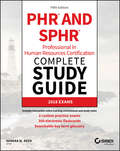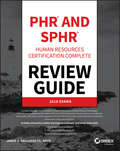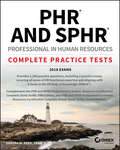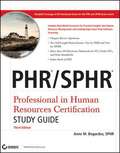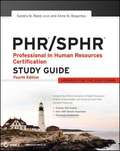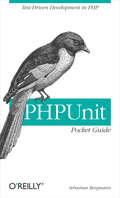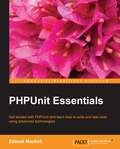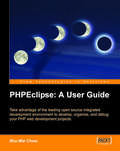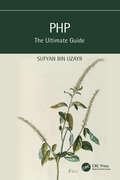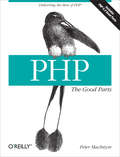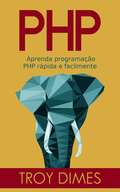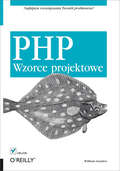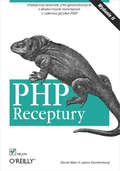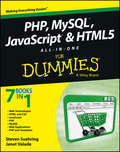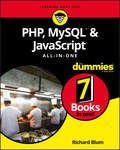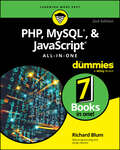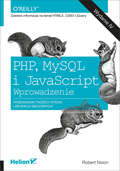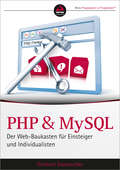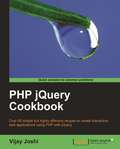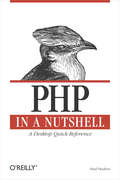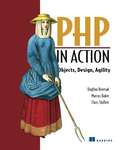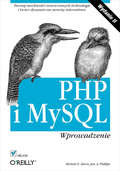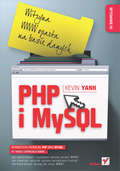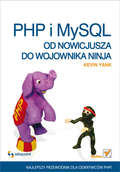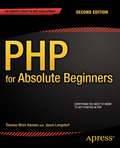- Table View
- List View
PHR and SPHR Professional in Human Resources Certification Complete Study Guide: 2018 Exams
by Sandra M. ReedThe #1 book for the leading HR certifications, aligned with the updated HRBoK™ PHR and SPHR certifications, offered by Human Resources Certification Institute (HRCI), have become the industry standard for determining competence in the field of human resources. Developed by working professionals, the PHR and SPHR credentials demonstrate that recipients are fully competent HR practitioners based on a standard set by workforce peers. Offering insights into those areas of knowledge and practices specific and necessary to human resource management (HRM), this study guide covers tasks, processes, and strategies as detailed in the updated A Guide to the Human Resource Body of Knowledge™ (HRBoK™). The study guide breaks down the critical HR topics that you need to understand as you prepare for the exams. PHR/SPHR Professional in Human Resources Certification Study Guide, Fifth Edition, is the ideal resource for HR professionals seeking to validate their skills and knowledge acquired through years of practical experience, as well as for a relative newcomer to the HR field looking to strengthen their resume. In this edition of the top-selling PHR/SPHR study guide, you’ll find a practical review of all topics covered on the exams, as well as study tools designed to reinforce understanding of key functional areas. Strengthen the skills you learn with a year of FREE access to the Sybex online learning environment, complete with flash cards and practice quizzes to prepare you for exam day. • Business Management and Strategy • Workforce Planning and Employment • Compensation and Benefits • Human Resource Development and more If you’re preparing for these challenging exams, this is the trusted study guide that’ll help you perform your best.
PHR and SPHR Professional in Human Resources Certification Complete Review Guide: 2018 Exams
by James J. Galluzzo IIIEssential review for the PHR/SPHR exams, aligned with the updated HRBoK™ PHR/SPHR Professional in Human Resources Certification Review Guide is the ideal companion to the PHR/SPHR Study Guide, Fifth Edition, and PHR/SPHR Deluxe Study Guide, Second Edition. These self-study guides are intended for HR professionals seeking to validate their skills and knowledge acquired through years of practical experience, or for relative newcomers to the HR field looking to strengthen their resume. Organized by those areas of knowledge and practices specific and necessary to human resource management (HRM), this handy review guide covers tasks, processes, and strategies as detailed in the updated A Guide to the Human Resource Body of Knowledge™ (HRBoK™), giving you clear guidance on what you need to know for the exams. You also get a year of FREE access to the Sybex online interactive learning environment and study tools, which feature flashcards, chapter tests, two bonus practice exams, and more. The review guide aligns with the HRCI test specifications, which detail the responsibilities and knowledge needed by today's HR professionals. Covers key functional areas in greater depth: HR students and professionals studying for the PHR/SPHR certification need a trusted resource to aid in their preparation—this review guide does that and more.
PHR and SPHR Professional in Human Resources Certification Complete Practice Tests: 2018 Exams
by Sandra M. Reed1,000 challenging practice questions to prepare for the PHR and SPHR exams! PHR/SPHR Professional in Human Resources Certification Practice Tests is the ideal complement to the PHR/SPHR Study Guide, Fifth Edition, PHR/SPHR Deluxe Study Guide, Second Edition, and Review Guide. These self-study guides are intended for HR professionals seeking to validate their skills and knowledge acquired through years of practical experience, or for relative newcomers to the HR field looking to strengthen their resume. These Practice Tests were developed to help certification candidates prepare for these challenging exams, especially for those needing more practice to review or refresh their knowledge right before exam day. The book aligns with A Guide to the Human Resource Body of Knowledge™ (HRBoK™), which details the responsibilities of and knowledge needed by today's HR professionals. Practice Tests reflect the critical HR topics that you need to understand as you prepare for the PHR and SPHRexams. • Business Management and Strategy • Workforce Planning and Employment • Human Resource Development • Risk Management and more Plus, you’ll get a year of FREE access to the interactive online learning environment and test bank, which includes full-length tests and practice exams—1,000 practice questions total!
PHR / SPHR Professional in Human Resources Certification Study Guide
by Anne M. BogardusMore than 80,000 HR professionals having earned the Senior Professional in Human Resources (SPHR) or Professional in Human Resources (PHR) certification, and another 20,000 are expected to take the exam in 2009. This complete update of the bestselling guide to HR certification contains additional coverage of new HR policies and standards, as well as updated practice exam questions and real world scenarios. Key topics include strategic management, workforce planning and employment, compensation and benefits, employee and labor relations, and Occupational Safety and Health Administration (OSHA) regulations. The CD-ROM contains two bonus exams (one each for PHR and SPHR) as well as flashcards and an electronic book.Note: CD-ROM/DVD and other supplementary materials are not included as part of eBook file.
PHR / SPHR Professional in Human Resources Certification Study Guide
by Anne M. Bogardus Sandra M. ReedUpdated edition of best-selling guide for PHR and SPHR candidates The demand for qualified human resources professionals is on the rise. The new Professional in Human Resources (PHR) and Senior Professional in Human Resources (SPHR) exams from the Human Resources Certification Institute (HRCI) reflect the evolving industry standards for determining competence in the field of HR. This new edition of the leading PHR/SPHR Study Guide reflects those changes. Serving as an ideal resource for HR professionals who are seeking to validate their skills and knowledge, this updated edition helps those professionals prepare for these challenging exams. Features study tools that are designed to reinforce understanding of key functional areas Provides access to bonus materials, including a practice exam for the PHR as well as one for the SPHR. Also includes flashcards and ancillary PDFs Addresses key topics such as strategic management, workforce planning and employment, compensation and benefits, employee and labor relations, and Occupational Safety and Health Administration regulations This new edition is must-have preparation for those looking to take the PHR or SPHR certification exams in order to strengthen their resume.
PHPUnit Pocket Guide: Test-Driven Development in PHP
by Sebastian BergmannSmart web developers will tell you that the sooner you detect your code mistakes, the quicker you can fix them, and the less the project will cost in the long run. Well, the most efficient way to detect your mistakes in PHP is with PHPUnit, an open source framework that automates unit testing by running a battery of tests as you go. The benefits of PHPUnit are significant:a reduction in the effort required to frequently test codefewer overall defectsadded confidence in your codeimproved relations with your open source teammates The only problem with this popular testing tool was its lack of documentation-until now, that is. For this, O'Reilly went right to the source, as Sebastian Bergmann, the author of PHPUnit Pocket Guide, also happens to be PHPUnit's creator. This little book brings together hard-to-remember information, syntax, and rules for working with PHPUnit. It also delivers the insight and sage advice that can only come from the technology's creator. Coverage of testing under agile methodologies and Extreme Programming (XP) is also included. The latest in O'Reilly's series of handy Pocket Guides, this quick-reference book puts all the answers are right at your fingertips. It's an invaluable companion for anyone interested in testing the PHP code they write for web applications.
PHPUnit Essentials
by Zdenek MachekThis book is a practical guide featuring a step-by-step approach that aims to help PHP developers who want to learn or improve their software testing skills. It also takes you through many reallife examples encountered by PHP developers to help you avoid common pitfalls. This book is a practical guide featuring a step-by-step approach that aims to help PHP developers who want to learn or improve their software testing skills. It also takes you through many reallife examples encountered by PHP developers to help you avoid common pitfalls.
PHPEclipse: A User Guide
by Shu-Wai ChowWritten in a concise and friendly style, packed with tips and a practical project, this book will instruct you on using PHPEclipse to make your PHP application development more efficient, and cut development time. This book is written for PHP developers who want an open source development environment for creating web applications. You do not need any knowledge of Java or prior experience of Eclipse to use this book.
PHP: The Ultimate Guide
by Sufyan bin UzayrThere is no shortage of websites that use the PHP programming language in some or other capacity. PHP (Hypertext Preprocessor) is a server-side scripting language that allows you to create dynamically-generated web pages. Rasmus Lerdorf created PHP in 1994. PHP works in the backend of a website because it is a server-side technology. This is the part of a website that no one sees. This means that PHP is frequently used to run server-side programs such as data collection and processing and database management. The fact that PHP is a simple language is one of the key reasons why learning it is a wise investment. PHP was created with the goal of speeding up web development; therefore, it features a basic syntax that is ideal for beginners. Furthermore, because PHP is a dynamically typed language, there are less restrictions to follow while creating features. The PHP programming language offers a wide range of applications and features, such as authentication, payments, user administration, and other "dynamic" aspects of a website. Efficiency, syntax compatibility, platform independence, error detection, and encryption are just a few of the interesting properties of PHP. Why Should You Learn PHP? PHP developers work with the PHP programming language to create websites, applications, and programs. As a PHP developer, you’ll usually be working in IT companies (all over the world), but there are also a lot of opportunities in design and business. A PHP developer, like any other programming/scripting language developer, should be able to work with many languages and ideally have some knowledge of database, web design, or some page formatting language. This Book Offers: • A step-by-step approach to problem solving and skill development • A quick run-through of the basic concepts, in the form of a "Crash Course" • Advanced, hands-on core concepts, with a focus on real-world problems • Industry-level coding paradigms and a practice-oriented explanatory approach • Special emphasis on writing clean and optimized code, with additional chapters focused on coding methodology
PHP: Delivering the Best of PHP
by Peter MacIntyreGet past all the hype about PHP and dig into the real power of this language. This book explores the most useful features of PHP and how they can speed up the web development process, and explains why the most commonly used PHP elements are often misused or misapplied. You'll learn which parts add strength to object-oriented programming, and how to use certain features to integrate your application with databases.Written by a longtime member of the PHP community, PHP: The Good Parts is ideal for new PHP programmers, as well as web developers switching from other languages.Become familiar with PHP's basic syntax, variables, and datatypesLearn how to integrate the language with web pagesUnderstand how to use strings, arrays, and PHP's built-in functionsDiscover the advantages of using PHP as an object-oriented languageExplore how PHP interacts with databases, such as SQLite and MySQLLearn input- and output-handling best practices to prevent security breaches
PHP: Aprenda programação PHP rápida e facilmente.
by Troy Dimes Paulo Alexandre Fernandes Martins TorresQuer aprender a habilidade em demanda de programação PHP... E fazê-lo rápido? Você é novo na programação de computadores ou apenas quer melhorar em algumas habilidades? Se assim for, este livro é um recurso maravilhoso para você. PHP é uma das mais amplamente utilizadas linguagens de programação open source, do lado do servidor. Se você está interessado em começar com programação e deseja obter algum conhecimento básico da línguagem PHP, então este livro é para você! Sites de famosos, incluindo Facebook e Yahoo são sustentados pelo PHP. É, em certo sentido, a línguagem do mundo! Conceitos básicos PHP, exemplos e exercícios incluídos. O livro aborda conceitos básicos PHP, começando do básico e movendo-se para PHP avançado, orientado aos objetos. Explica e demonstra tudo pelo caminho. Você estará a programar em PHP num instante. Ótimo para iniciantes ou aqueles que têm alguma experiência de codificação. Este é um livro profundo, escrito por um perito para pessoas como você. Você pode saber algumas coisas sobre programação ou codificação de computadores, mas ainda quer aprender mais. Você encontrará que este livro é tão simples de digerir e fornece instruções passo a passo para que você não tenha nenhum problema a acompanhar. Aqui está apenas algo do que você vai aprender: *O que é o PHP, por que você deve usá-lo, e exatamente como ele funciona. *Como preparar seu computador para a programação em PHP. (Imagens incluídas) *Como criar rapidamente e facilmente as suas próprias aplicações web baseadas em PHP. *Muitas dicas úteis e truques sobre como programar em PHP com facilidade. *Muito mais...
PHP. Wzorce projektowe
by William SandersCi?g?y rozwój j?zyka PHP sprawia, ?e za jego pomoc? mo?na ju? tworzy? bardzo zaawansowane aplikacje. Wszyscy programi?ci wiedz?, ?e wraz ze wzrostem skomplikowania tworzonego oprogramowania konieczne staje si? zastosowanie sprawdzonych, przemy?lanych i przetestowanych rozwi?za?. Takim zbiorem najlepszych metod rozwi?zywania typowych problemów s? wzorce projektowe. Zawita?y one równie? do ?wiata PHP!Na rynku znajdziesz wiele ksi??ek po?wi?conych wzorcom projektowym, jednak dotycz? one zazwyczaj j?zyków Java lub C. Ta wyj?tkowa ksi??ka zajmuje si? wzorcami w j?zyku PHP. W trakcie lektury poznasz podstawowe za?o?enia programowania obiektowego, wzorce czynno?ciowe, kreacyjne i strukturalne. Przekonasz si? te?, jak bardzo wzro?nie jako?? Twojego kodu, je?eli do komunikacji z baz? danych MySQL zastosujesz wzorzec Proxy. Ksi??ka ta jest obowi?zkow? lektur? ka?dego programisty pisz?cego w j?zyku PHP. Zobacz, jak dobry mo?e by? Twój kod!Wzorce projektowe w PHP to:najlepsze rozwi?zania typowych problemówsposób na popraw? jako?ci Twojego kodu?atwiejsza komunikacja z baz? danych MySQLmniej b??dów w Twoich aplikacjach Przekonaj si?, jak tworzy? kod wysokiej jako?ci!
PHP. Receptury. Wydanie II
by David Sklar Adam TrachtenbergPodr?czny s?ownik 250 sprawdzonych i skutecznych rozwišza? z zakresu j?zyka PHP Praca z typami danych i blokami programów PHP Obs?uga formularzy, baz danych i sesji Tworzenie wydajnych i bezpiecznych witryn internetowych PHP to najpopularniejszy j?zyk skryptowy na ?wiecie, wykorzystywany w milionach witryny internetowych. Szeroki wachlarz mo?liwo?ci, ?atwa sk?adnia oraz wspó?praca z wieloma systemami operacyjnymi sprawiajš, ?e jest to idealne narz?dzie do tworzenia dynamicznych aplikacji WWW. Od wersji PHP 5 j?zyk ten obs?uguje programowanie obiektowe oraz udost?pnia usprawniony mechanizm wspó?pracy z bazami danych, co w znacznym stopniu u?atwia kreowanie rozbudowanych programów sieciowych. Drugie wydanie ksiš?ki "PHP. Receptury" zawiera jeszcze wi?cej gotowych rozwišza?, które zosta?y dostosowane do nowej wersji j?zyka, czyli PHP 5. Dodatkowo ulepszona forma umo?liwia ?atwiejsze znalezienie potrzebnych receptur. Pozwolš Ci one szybko rozwišza? cz?sto spotykane problemy. Czytajšc t? ksiš?k? dowiesz si? mi?dzy innymi, jak wykonywa? operacje na ró?nych typach danych, jakie elementy sk?adajš si? na programy PHP i jak z nich korzysta?, a tak?e jak obs?ugiwa? formularze czy wspó?pracowa? z bazami danych. Nauczysz si? stosowa? techniki zarzšdzania sesjami. Poznasz zasady korzystania z XML, wspó?pracy z kodem w j?zyku JavaScript, a tak?e rozwišzania wielu innych praktycznych problemów. Praca z typami danych Korzystanie z ró?nych bloków aplikacji PHP Obs?uga formularzy Praca z bazami danych Przetwarzanie dokumentów XML Us?ugi Web Services Zarzšdzanie sesjš Generowanie grafiki na stronach internetowych Zabezpieczanie witryn Obs?uga b??dów Optymalizacja kodu Praca z systemem plików i katalogów Wykorzystaj gotowy kod do b?yskawicznego tworzenia dynamicznych witryn internetowych.
PHP, MySQL, JavaScript & HTML5 All-in-One For Dummies
by Steve Suehring Janet ValadeGet the basics on four key web programming tools in one great book! PHP, JavaScript, and HTML5 are essential programming languages for creating dynamic websites that work with the MySQL database. PHP and MySQL provide a robust, easy-to-learn, open-source solution for creating superb e-commerce sites and content management. JavaScript and HTML5 add support for the most current multimedia effects. This one-stop guide gives you what you need to know about all four! Seven self-contained minibooks cover web technologies, HTML5 and CSS3, PHP programming, MySQL databases, JavaScript, PHP with templates, and web applications. Addresses how PHP, MySQL, JavaScript, and HTML5 are vital tools for creating dynamic, database-driven websites and are especially important for e-commerce sites Serves as essential reading for web designers who are new to these technologies, offering a crash course covering all of these powerful technologies in this handy volume of seven self-contained minibooks Covers how to program in PHP and how to create and administer a MySQL database as well as how to manipulate MySQL data via a web interface Shows how to create a secure website and how to code popular e-business applications such as login programs and shopping carts With seven books in one, PHP, MySQL, JavaScript & HTML5 All-in-One For Dummies will turn your website into the center of attention in no time at all.
PHP, MySQL, & JavaScript All-in-One For Dummies
by Richard BlumExplore the engine that drives the internet It takes a powerful suite of technologies to drive the most-visited websites in the world. PHP, mySQL, JavaScript, and other web-building languages serve as the foundation for application development and programming projects at all levels of the web. Dig into this all-in-one book to get a grasp on these in-demand skills, and figure out how to apply them to become a professional web builder. You’ll get valuable information from seven handy books covering the pieces of web programming, HTML5 & CSS3, JavaScript, PHP, MySQL, creating object-oriented programs, and using PHP frameworks. Helps you grasp the technologies that power web applications Covers PHP version 7.2 Includes coverage of the latest updates in web development Perfect for developers to use to solve problems This book is ideal for the inexperienced programmer interested in adding these skills to their toolbox. New coders who've made it through an online course or boot camp will also find great value in how this book builds on what you already know.
PHP, MySQL, & JavaScript All-In-One For Dummies
by Richard BlumLearn the essentials of creating web apps with some of the most popular programming languages PHP, MySQL, & JavaScript All-in-One For Dummies bundles the essentials of coding in some of the most in-demand web development languages. You'll learn to create your own data-driven web applications and interactive web content. The three powerful languages covered in this book form the backbone of top online apps like Wikipedia and Etsy. Paired with the basics of HTML and CSS—also covered in this All-in-One Dummies guide—you can make dynamic websites with a variety of elements. This book makes it easy to get started. You'll also find coverage of advanced skills, as well as resources you'll appreciate when you're ready to level up. Get beginner-friendly instructions and clear explanations of how to program websites in common languages Understand the basics of object-oriented programming, interacting with databases, and connecting front- and back-end code Learn how to work according to popular DevOps principles, including containers and microservices Troubleshoot problems in your code and avoid common web development mistakes This All-in-One is a great value for new programmers looking to pick up web development skills, as well as those with more experience who want to expand to building web apps.
PHP, MySQL i JavaScript. Wprowadzenie. Wydanie IV
by Robert NixonPrzewodnik twórcy stron i aplikacji sieciowych!PHP wraz z baz? danych MySQL oraz j?zykiem JavaScript to pot??ne trio, dzi?ki któremu mo?esz zbudowa? aplikacj? internetow? dowolnej wielko?ci. Je?eli do tego do?o?ysz mo?liwo?ci najnowszej wersji j?zyka HTML (oznaczonej cyfr? 5), CSS3 oraz bibliotek? jQuery, nic nie b?dzie w stanie zatrzyma? Twojej kreatywno?ci.Je?eli chcesz opanowa? te narz?dzia i stworzy? atrakcyjn? oraz funkcjonaln? aplikacj? internetow?, trafi?e? na idealn? ksi??k?. Znajdziesz tu niezb?dn? wiedz? o j?zyku PHP, bazie danych MySQL, HTML5, CSS3, JavaScripcie i jQuery. Ju? od pierwszych stron zaczniesz poznawa? sk?adni? oraz konstrukcje j?zyka programowania PHP, techniki programowania obiektowego oraz praktyczne porady zwi?zane z u?ywaniem PHP. Nast?pnie uzupe?nisz wiedz? na temat bazy danych MySQL. Dowiesz si?, jak tworzy? zapytania SQL oraz w jaki sposób wykorzysta? dane zawarte w bazie z poziomu PHP. Po opanowaniu „strony serwerowej” przejdziesz do nauki technik tworzenia interaktywnych stron WWW. Zobaczysz, jak u?ywa? j?zyka JavaScript, jakie nowo?ci zawiera HTML5 oraz jak wielki potencja? kryj? w sobie CSS3 i jQuery. Ksi??ka ta jest ciekaw? lektur? dla pasjonatów chc?cych tworzy? w?asne, zaawansowane aplikacje. Dog??bnie opanuj j?zyk PHP, pocz?wszy od podstaw a? do metod programowania obiektowego. Zapoznaj si? z MySQL, od struktury bazy danych do skomplikowanych zapyta?. Naucz si? u?ywa? rozszerzenia MySQLi — udoskonalonego interfejsu PHP dla MySQL. Twórz dynamiczne strony PHP, które dostosowuj? si? do u?ytkownika. Zarz?dzaj ciasteczkami i sesjami, z zachowaniem wysokich standardów bezpiecze?stwa. Opanuj j?zyk JavaScript i wzboga? go z u?yciem jQuery. Wykorzystaj ??dania Ajax do komunikacji mi?dzy przegl?dark? a serwerem. U?yj CSS2 i CSS3 do opracowania profesjonalnej szaty graficznej stron WWW. Poznaj nowe funkcje HTML5, w tym geolokacj?, obs?ug? d?wi?ku i filmów oraz elementu canvas.Kompendium wiedzy dla twórcy stron i aplikacji sieciowych
PHP und MySQL: Der Web-Baukasten für Einsteiger und Individualisten
by Giesbert DamaschkeSie haben schon eigene Webseiten gebaut und möchten diese nun mit Funktionen ausstatten, für die Sie PHP und MySQL benötigen? Giesbert Damaschke zeigt Ihnen in diesem Buch, wie Sie das schaffen. Schritt für Schritt erlernen Sie die benötigten Programmier- und Datenbankgrundlagen - immer im Rahmen von typischen dynamischen Anwendungen. So erheben und speichern Sie zum Beispiel mit Formularen Kontaktdaten, prüfen Benutzereingaben, erstellen Menüs, richten einen Besucherzähler ein, verschicken E-Mails mit PHP oder entwickeln sogar einen eigenen Blog. Alle Codebeispiele werden ausführlich erklärt, sodass Sie sich schnell zurechtfinden werden, wenn Sie ein wenig HTML und CSS beherrschen. Programmier- oder Datenbankkenntnisse werden nicht vorausgesetzt. Jedes Kapitel bietet Ihnen Übungsaufgaben, an denen Sie Ihr neu gewonnenes PHP- und MySQL-Wissen praktisch testen können. Die lauffähigen Musterlösungen können Sie zusammen mit den Beispieldateien herunterladen, um sich daran zu orientieren oder auch gleich in Ihre Website einzubauen. So gelingt Ihnen der Einstieg in PHP und MySQL mit Sicherheit!
PHP jQuery Cookbook
by Vijay JoshiWritten in Packt's cookbook style, this book presents numerous practical examples that you can use directly in your applications. The book covers most of the essential issues you will face while developing your web applications and gives solutions to them. Recipes in the book are written in a manner that will rapidly take you from a beginner to expert level.If you want to use PHP and jQuery together to create web applications this book is for you. It provides a large number of examples in each chapter that will take you from a basic developer to a pro by giving step-by-step instructions for each task in developing web applications using PHP and jQUery. All you need are JavaScript basics and you are on your way to building power web applications, with this book in hand.
PHP in a Nutshell: A Desktop Quick Reference
by Paul HudsonNow installed on more than 20 million Internet domains around the world, PHP is an undisputed leader in web programming languages. Database connectivity, powerful extensions, and rich object-orientation are all reasons for its popularity, but nearly everyone would agree that, above all, PHP is one of the easiest languages to learn and use for developing dynamic web applications. The ease of development and simplicity of PHP, combined with a large community and expansive repository of open source PHP libraries, make it a favorite of web designers and developers worldwide.PHP in a Nutshell is a complete reference to the core of the language as well as the most popular PHP extensions. This book doesn't try to compete with or replace the widely available online documentation. Instead, it is designed to provide depth and breadth that can't be found elsewhere. PHP in a Nutshell provides the maximum information density on PHP, without all the fluff and extras that get in the way. The topic grouping, tips, and examples in this book complement the online guide and make this an essential reference for every PHP programmer. This book focuses on the functions commonly used by a majority of developers, so you can look up the information you need quickly. Topics include:Object-oriented PHPNetworkingString manipulationWorking with filesDatabase interactionXMLMultimedia creationMathematicsWhether you're just getting started or have years of experience in PHP development, PHP in a Nutshell is a valuable addition to your desk library.
PHP in Action: Objects, Design, Agility
by Chris Shiflett Marcus Baker Dagfinn ReiersolTo keep programming productive and enjoyable, state-of-the-art practices andprinciples are essential. Object-oriented programming and design help managecomplexity by keeping components cleanly separated. Unit testing helps preventendless, exhausting debugging sessions. Refactoring keeps code supple andreadable. PHP offers all this-and more.PHP in Action shows you how to apply PHP techniques and principles to all themost common challenges of web programming, including:Web presentation and templatesUser interaction including the Model-View-Contoller architectureInput validation and form handlingDatabase connection and querying and abstractionObject persistence Purchase of the print book comes with an offer of a free PDF, ePub, and Kindle eBook from Manning. Also available is all code from the book.
PHP i MySQL. Wprowadzenie. Wydanie II
by Michele E. Davis Jon A. PhillipsPoznaj mo?liwo?ci nowoczesnych technologii i twórz dynamiczne serwisy internetowe Jak sprawdzi? poprawno?? danych i obs?ugiwa? b??dy?Jak zapisywa? nazwy u?ytkowników i has?a w bazie danych?Jak tworzy? zapytania do bazy danych za pomoc? funkcji PHP?PHP i MySQL to ju? standardowe technologie do tworzenia dynamicznych stron internetowych wykorzystuj?cych bazy danych. Istotne jest, ?e zapewniaj? one nie tylko interaktywno??, ale równie? wysoki stopie? bezpiecze?stwa witryn WWW. Ich ogromne mo?liwo?ci powoduj?, ?e wykorzystywane s? do tworzenia zarówno prostych aplikacji, jak i skomplikowanych stron internetowych, zaopatrzonych w rozbudowane systemy autoryzacji, na przyk?ad ró?nego rodzaju sklepy internetowe. Po??czenie PHP i MySQL stanowi wi?c niezast?pione narz?dzie do tworzenia dynamicznych witryn, spe?niaj?cych wymagania zarówno administratorów, jak i u?ytkowników.Ksi??ka "PHP i MySQL. Wprowadzenie. Wydanie II" przedstawia krok po kroku zasady tworzenia serwisów WWW z wykorzystaniem baz danych. W podr?czniku na przyk?adach przedstawiono m.in. sposoby pracy z baz? danych MySQL, serwerem WWW Apache czy j?zykiem PHP i XHTML. Czytaj?c t? ksi??k?, nauczysz si? przeprowadza? operacje na danych, zarz?dza? sesjami i tabelami oraz tworzy? zapytania. "Learning PHP &My SQL" stanowi niezb?dny podr?cznik zarówno dla pocz?tkuj?cych Czytelników, jak i programistów, którzy mieli wcze?niej do czynienia z j?zykiem HTML, a teraz chc? tworzy? dynamiczne i bezpieczne strony internetowe.Tre?? generowana dynamicznie i InternetPodejmowanie decyzji w PHPFunkcje i tablicePobieranie danych z kilku tabelPraca z baz? danych MySQLOperatory logiczneWspó?praca PHP i MySQLFormularze siecioweXHTMLPliki cookie, sesje i kontrola dost?puModyfikowanie obiektów MySQL i danych PHPOto ca?a, aktualna wiedza, której potrzebujesz, aby tworzy? interaktywne strony WWW.
PHP i MySQL. Witryna WWW oparta na bazie danych. Wydanie IV
by Kevin YankWykorzystaj potencja? PHP oraz MySQL w Twoich serwisach WWW! Jak zainstalowa? i uruchomi? w?asny serwer WWW?Jak stworzy? autorski system zarzšdzania tre?ciš?Jak kontrolowa? dost?p do stron WWW?PHP i MySQL to najpopularniejszy tandem webmasterski. Ilo?? serwisów opartych na tym po?šczeniu jest nie do ogarni?cia. Skšd taka popularno??? Niezale?nie od innych zalet atutem tego rozwišzania jest prostota. Ju? kilka chwil wystarczy, ?eby rozpoczš? przygod? z profesjonalnym tworzeniem serwisów WWW. A je?eli po?wi?cisz troch? wi?cej czasu, poznasz i wykorzystasz jeszcze wi?cej mo?liwo?ci PHP i MySQL. Ale czy rzeczy proste nie mogš by? jeszcze prostsze?Mogš. Z ksiš?kš "PHP i MySQL. Witryna WWW oparta na bazie danych. Wydanie IV" b?yskawicznie przebrniesz przez proces instalacji wszystkich niezb?dnych komponentów — niezale?nie od systemu, którego u?ywasz. Autor opisuje tu sposób instalacji na platformach Windows, MacOS X oraz Linux. Po udanej instalacji napiszesz swój pierwszy skrypt, a nast?pnie przejdziesz do kolejnych, coraz bardziej zaawansowanych tematów. W?ród nich znajdziesz opisy takich zagadnie?, jak: j?zyk SQL, sk?adnia PHP, nawišzywanie po?šczenia z bazš, publikowanie tre?ci znajdujšcych si? w bazie. Ponadto zdob?dziesz wiedz? z zakresu administrowania bazš MySQL, systemów zarzšdzania tre?ciš, zarzšdzania sesjš czy te? wykorzystania wyra?e? regularnych. Ksiš?ka ta jest nieocenionš pomocš dla wszystkich osób zaczynajšcych przygod? ze stronami WWW oraz j?zykami PHP i SQL.Instalacja systemu na platformach Windows, Linux oraz MacOS XMySQL — podstawowe zagadnieniaPHP — sk?adnia, podstawowe polecenia i strukturyNawišzywanie po?šczenia z bazš danych z poziomu PHPPublikacja tre?ci zawartych w bazie MySQLZasady projektowania relacyjnej bazy danychTworzenie systemu zarzšdzania tre?cišWykorzystanie wyra?e? regularnychKontrola dost?pu do stronZarzšdzanie sesjš oraz "ciasteczkami"Zadania administracyjne w bazie MySQLTworzenie zaawansowanych zapyta? MySQLPrzechowywanie i wykorzystanie danych binarnych Twórz dynamiczne, bogate w tre?ci i ?atwe w zarzšdzaniu witryny WWW!
PHP i MySQL. Od nowicjusza do wojownika ninja
by Kevin YankNajlepszy przewodnik dla odkrywców PHP!J?zyk PHP wci?? zyskuje na popularno?ci. Kolejne wersje, ci?g?e ulepszenia sprawiaj?, ?e w niektórych obszarach zaczyna on rywalizowa? z weteranami na rynku j?zyków programowania. Ten trend wida? równie? w ofertach pracy. Programi?ci biegle znaj?cy PHP s? wr?cz rozchwytywani na rynku! Warto do??czy? do tego grona. Je?li chcesz tworzy? zaawansowane aplikacje i pozna? PHP na wylot, trafi?e? na wymarzon? ksi??k?!Dzi?ki niej ju? wkrótce staniesz si? prawdziwym ninj? programowania w PHP. Przeprowadzi Ci? ona przez wszystkie etapy poznawania j?zyka: skonfigurujesz serwer WWW i MySQL oraz PHP. Nast?pnie zaprojektujesz swoj? pierwsz? baz? i pod??czysz si? do niej, ?eby zapisa? i pobra? dane. W kolejnych rozdzia?ach przekonasz si?, jak wyra?enia regularne mog? Ci pomóc w codziennej pracy, dlaczego nale?y korzysta? z sesji oraz co mo?esz zapisa? w „ciasteczkach”. „PHP i MySQL. Od nowicjusza do wojownika ninja” jest genialnym przewodnikiem po PHP i MySQL. Pozwoli Ci przeobrazi? si? z laika w profesjonalist?. Zainwestuj w t? wiedz?!B?yskawicznie opanuj:konfiguracj? serwera WWW i bazy danych MySQLpobieranie danych z bazy i zapisywanie ich do bazysposoby wykorzystania sesji i plików cookiesniuanse j?zyka PHPZainwestuj w now? wiedz? o j?zyku PHP!
PHP for Absolute Beginners
by Thomas Blom Hansen Jason LengstorfPHP is a server-side scripting language that enables you to develop dynamic sites that engage users in ways that are simply not possible using only HTML and CSS. PHP for Absolute Beginners takes a practical approach to teaching you how to build dynamic content for your website using PHP. You'll quickly get started with practical PHP projects, learning how to build a dynamic image gallery. By the end of the book you'll will have developed a personal blog complete with a password protected admin module. PHP for Absolute Beginners won't swamp you with every detail of the full PHP language up front - instead, you'll be introduced to a small, versatile subset of PHP and learn to use it creatively to develop dynamic web sites. In the process you will learn to use variables, control structures, functions, and objects to your advantage. You will learn how to plan and create databases and how to organize your PHP scripts beautifully. At the end of the book, you will be a confident PHP user, ready to take the next steps in creating great websites.
